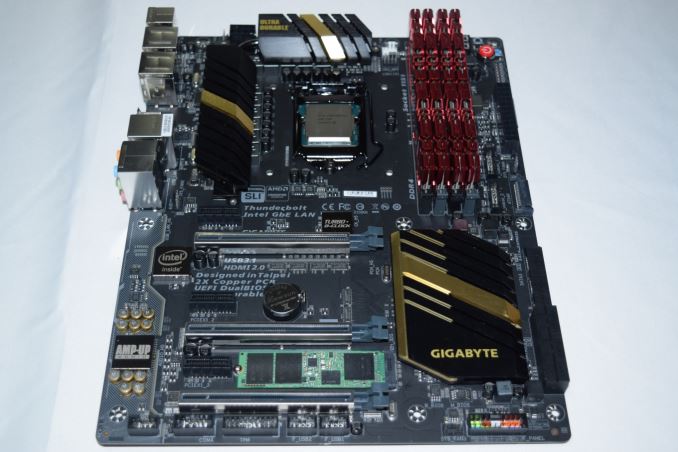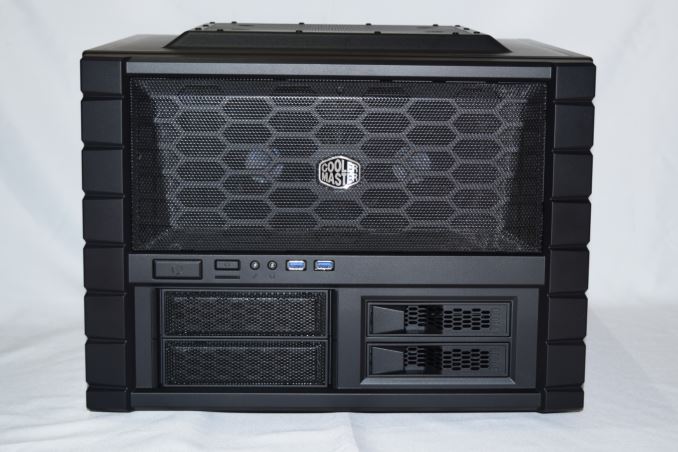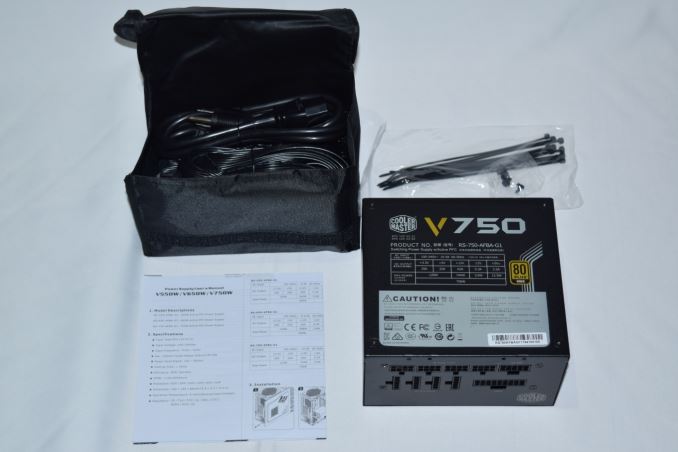Samsung Portable SSD T3 Review
by Ganesh T S on February 22, 2016 10:00 AM ESTThe Skylake DAS Testbed Build
The rising popularity of USB 3.1 (both Gen 1 and Gen 2) Type-C direct-attached storage (DAS) devices and the upcoming Thunderbolt 3 DAS units made it clear that I had to work on some updates to our direct-attached storage testbed. Originally based on the Haswell platform, the DAS testbed used a Thunderbolt 2 PCIe add-on card and the USB 3.0 ports hanging off the PCH. For a brief while, I also added USB 3.1 Gen 2 Type-A and Type-C PCIe cards to evaluate a few DAS units.
The introduction of Skylake has been quite interesting from the viewpoint of fast local storage. While the 100-series chipset doesn't have native USB 3.1 Gen 2 support, it does have plenty of high-speed PCIe 3.0 lanes that enable high-speed bridges to other protocols. Motherboard vendors have decided to enable USB 3.1 on entry-level boards with an ASMedia bridge chip. However, premium boards can be equipped with Intel's own Alpine Ridge controller.
Thunderbolt 3 and Intel's Apline Ridge are interesting for a few reasons (I will go more in detail into these in the review of our first Thunderbolt 3 DAS unit):
- In addition to Thunderbolt 3, Alpine Ridge also integrates a USB 3.1 Gen 2 (10 Gbps) host controller
- Thunderbolt 3 works over a Type-C interface, and supports a couple of additional protocols - USB 3.1 Gen 2 and DisplayPort 1.2
Considering these aspects, it made sense to migrate to Skylake for our DAS testbed. In particular, I looked out for a board with Alpine Ridge integrated. Ian published the review of the GIGABYTE Z170X-UD5 TH last Friday, and it turned out that the board perfectly fit the requirements. Intel provided us with a sample of the Core i5-6600K to use in the board. G.Skill also came forward with four 8GB DDR4 DIMMs to give the testbed 32GB of DRAM (the same as our Haswell-based testbed)
The Corsair Carbide Series Air 540 chassis in our Haswell-based testbed has been great in terms of footprint, ventilation and easy access to components. Two hot-swap internal SATA slots turned out to be a boon for quick secure erases of SSDs as well as benchmarking of internal HDDs meant for NAS usage in the single-disk mode. However, this unintended usage model (I wasn't planning on doing this frequently when I first opted for the Corsair Air 540) was a bit of a hassle, since one of the chassis sides had to be dismounted to access the hot-swap slots. I wanted to address this issue in the new testbed.
In the lookout for a ATX chassis for the new testbed, I had three main requirements:
- Hot-swap bays accessible without the need to open up the unit (similar to the drive slots in hot-swap NAS units)
- Portability in terms of being easy to shift from one location in the lab to another (something I realized as important when trying to test daisy chaining with a Thunderbot 2 DAS unit last year)
- Cubical footprint with horizontal motherboard orientation in order to better fit in a workbench and enable easy swapping out of PCIe cards in the future
The Cooler Master HAF XB EVO perfectly fit our requirements. The two X-Dock bays fulfilled our need for hot-swap bays for both 3.5" and 2.5" drives. Since the unit is marketed as a LAN box, it has two rigid carry handles on the side panels to enable portability. The unit can also easily serve as a testbench. Only the top cover (held in place by two screws at the back) needs to be removed in order to access the PCIe cards. The PSU slot also extends slightly out, enabling easier cable management inside the chassis. With plenty of additional drive slots in addition to the X-Dock, it was a no-brainer to go with the Cooler Master HAF XB EVO.
We have traditionally gone with the chassis vendor for the PSU also in our testbeds. Cooler Master suggested the fully modular V750 for use in our system.
Even though a 750W PSU is an overkill for a system with no discrete GPUs, the rating makes sure that we have the option in the future. The fully modular nature also helped greatly in cable management.
In addition to the above, we made use of a few components that were salvaged from earlier reviews / unused components from previous builds - a Corsair Hydro Series H105 liquid CPU cooler, a Samsung SM951 NVMe PCIe 3.0 x4 SSD for the boot drive, and an Intel 730 series 480 GB SSD and a Corsair Neutron XT 480 GB SSD for use as staging drives for temporary data. The gallery below provides some more pictures from our build process.
Evaluation of DAS units on Windows is being done with the testbed outlined in the table below. For devices with a USB 3.1 Gen 1 (USB 3.0 via a Type-C interface) connections (such as the Samsung Portable SSD T3 2TB that we are considering today), we utilize the USB 3.1 Type-C port enabled by the Intel Alpine Ridge controller. It connects to the Z170 PCH via a PCIe 3.0 x4 link..
| AnandTech DAS Testbed Configuration | |
| Motherboard | GIGABYTE Z170X-UD5 TH ATX |
| CPU | Intel Core i5-6600K |
| Memory | G.Skill Ripjaws 4 F4-2133C15-8GRR 32 GB ( 4x 8GB) DDR4-2133 @ 15-15-15-35 |
| OS Drive | Samsung SM951 MZVPV256 NVMe 256 GB |
| SATA Devices | Corsair Neutron XT SSD 480 GB Intel SSD 730 Series 480 GB |
| Add-on Card | None |
| Chassis | Cooler Master HAF XB EVO |
| PSU | Cooler Master V750 750 W |
| OS | Windows 10 Pro x64 |
| Thanks to Cooler Master, GIGABYTE, G.Skill and Intel for the build components | |
The list of DAS units used for comparison purposes is provided below.
- Samsung Portable SSD T3 2TB
- Corsair Voyager GTX v2 256GB
- LaCie Rugged Thunderbolt 500GB
- Samsung Portable SSD T1 1TB - No Encryption
- SanDisk Extreme 500 240GB - USB 3.0



















49 Comments
View All Comments
bill44 - Monday, February 22, 2016 - link
"In a bus-powered enclosure, it is difficult to put incorporate PCIe SSDs."USB 3.1 Gen 2 can provide more power (don't know if that's enough though). TB3 can go one better (up to 100W).
Would be nice to see a PCIe 3 x 4 SSD in a USB 3.1 Gen 2 or TB3 enclosure that does not use SATA mode.
Doubt we will ever see a bridge-chipset other than what we see here (that uses SATA mode).
ganeshts - Monday, February 22, 2016 - link
It will be risky for device vendors to implement. The reason is that most PC or phone USB Type-C ports will only implement the minimum required option - which is 5V at 900mA - even with 3.1 Gen 2 ports. If you have a drive with higher power requirements, it might not be compatible with many of the USB ports out there - only those that implement USB Power Delivery (where the minimum is 5V at 2A).Yes, Thunderbolt 3 does provide a little bit of leeway - 15W is the minimum (5V at 3A).
BillyONeal - Monday, February 22, 2016 - link
The connector standard provides that much power, but few implementations actually do.bill44 - Monday, February 22, 2016 - link
If we always take the lowest common denominator, we will never move forward. I see your point though, but shouldn't there be a power user option? We have the tech where a single (non-raid) PCIe SSD would be able to saturate the 3.1 Gen 2 interface, but, if We want performance, we have to make do with 2x SATA SSDs in RAID. Which is more expensive and not as fast.Leosch - Tuesday, March 15, 2016 - link
Sorry but this is wrong and irks me to read again and again.100 W is not provided by Thunderbolt 3, but by USB Power Delivery 2.0. Thunderbolt 3.0 also does not have additional protocols as the article claims but is instead one of multiple USB Alternate Modes the most popular of the others being Display Port 1.2.
So many great features of the new USB standards and the new USB connecter get ascribed to Thunderbolt 3 even though it is just piggybacking as an alternate mode over the same link.
lordmocha - Sunday, March 27, 2016 - link
Why do you say TB3 can go one better than USB 3.1 Gen 2? What about USB Power Delivery 1.2 which is 100W which you can get in a Type-C port without TB3 capability...Magichands8 - Monday, February 22, 2016 - link
So TRIM support is indeterminate? I'd really like to know why there wasn't even an attempt to see if it could be established with this drive. As a potential buyer I would be really interested in knowing if the T3 is going to gradually turn into a paperweight just from normal use. It's kind of relevant.dano_spumoni - Wednesday, February 24, 2016 - link
yes, it's disturbing that they won't at least confirm or deny TRIM support, it's kind of a big deal for an expensive external SSD.name99 - Monday, February 22, 2016 - link
Why did you not give the power required (at maximum usage, generally lots of back-to-back random writes)?This is especially important for bus-powered drives because it tells us whether the drive can (or cannot) usefully be connected to an old-style USB-2 computer, or whether we need to be especially careful in how much power we provide to a USB-3 hub.
royalcrown - Monday, February 22, 2016 - link
$ 850 USD for 2 TB...no thank you.